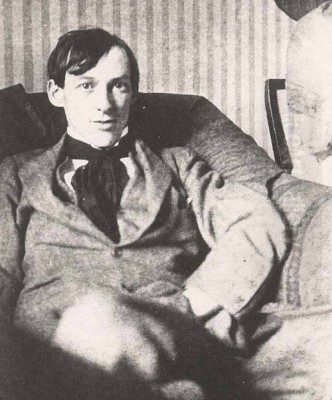
James Dickson Innes stands as a poignant and luminous figure in the landscape of early 20th-century British art. A painter of intense vision and vibrant colour, his tragically short career nevertheless left an indelible mark, particularly through his passionate depictions of the Welsh mountains and his brief but influential association with the Arenig School. His work, imbued with a Post-Impressionist sensibility and a deeply personal connection to nature, captured a unique moment of artistic ferment in Britain, bridging late Romanticism with emerging modern European influences.
Early Life and Artistic Awakening
Born on February 27, 1887, in Llanelli, Carmarthenshire, South Wales, James Dickson Innes was the son of John Innes, a historian of Scottish descent with an expertise in copper trade, and his wife, who was of Catalan heritage. This mixed ancestry perhaps contributed to the passionate and somewhat exotic temperament that would later define his art. Llanelli, a bustling industrial town at the time, provided a stark contrast to the wild, untamed landscapes that would later captivate his imagination.
His artistic inclinations were apparent from an early age. He first received formal art training at the Carmarthen School of Art (1904-1905). His talent was promising enough to secure him a place at the prestigious Slade School of Fine Art in London, which he attended from 1905 to 1908. The Slade, under the formidable tutelage of figures like Henry Tonks, Philip Wilson Steer, and Fred Brown, was a crucible for many of the most significant British artists of the era. Here, Innes was exposed to rigorous academic training but also to the burgeoning ideas of modern art that were beginning to permeate the London art scene. During his time at the Slade, he distinguished himself by winning the Slade Scholarship, a testament to his burgeoning abilities.
It was also at the Slade that he formed important friendships with fellow students who would become notable artists in their own right, including Augustus John, Derwent Lees, and Spencer Gore. These connections, particularly with John and Lees, would prove crucial to his artistic development and his later explorations of the Welsh landscape.
The Formation of a Distinctive Style
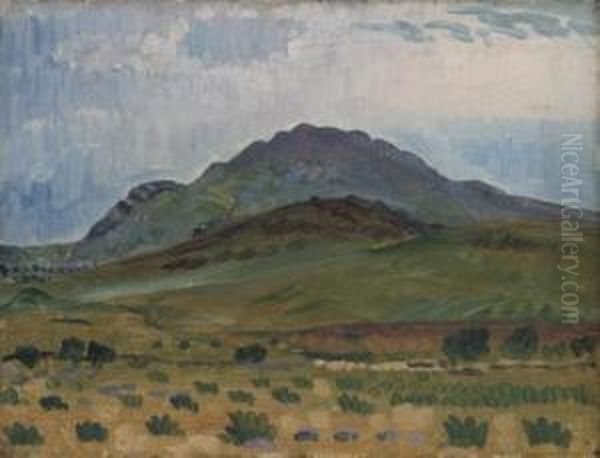
Innes's early work showed an assimilation of various influences. He deeply admired the great British landscape masters, J.M.W. Turner and John Constable, whose dramatic use of light and atmospheric effects resonated with his own burgeoning sensibility. However, he was also keenly aware of contemporary European art movements. The groundbreaking Post-Impressionist exhibitions organized by Roger Fry in London in 1910 ("Manet and the Post-Impressionists") and 1912 ("Second Post-Impressionist Exhibition") had a profound impact on many young British artists, including Innes. These exhibitions introduced British audiences to the radical work of artists like Paul Cézanne, Vincent van Gogh, Paul Gauguin, and Henri Matisse.
Innes's style evolved rapidly, moving towards a more expressive and subjective interpretation of landscape. He developed a distinctive technique characterized by the use of bold, often non-naturalistic colours, simplified forms, and a direct, almost urgent application of paint. His palette became rich and jewel-like, employing vibrant vermilions, emerald greens, deep Prussian blues, and luminous yellows to convey the emotional intensity of his response to nature. This approach shared affinities with French Fauvism, particularly in its liberation of colour from purely descriptive purposes, and to some extent with German Expressionism in its emphasis on subjective feeling.
He often worked on small wooden panels, applying paint quickly and fluidly, sometimes leaving areas of the panel bare to contribute to the overall texture and luminosity of the work. This method allowed him to capture the fleeting effects of light and weather, and imbued his paintings with a sense of immediacy and spontaneity. While his drawing skills were perhaps not as conventionally strong as some of his contemporaries, he compensated with an intuitive grasp of composition and an extraordinary sensitivity to colour harmonies. His landscapes, though rooted in specific locations, often possess a dreamlike, almost mystical quality.
The Welsh Landscape and the Arenig School
The rugged, mountainous terrain of North Wales became a central and enduring passion for Innes. He was particularly drawn to the Arenig Fawr mountain near Bala. This dramatic peak, with its stark beauty and ever-changing moods, became a recurring motif in his work. It was here, in the vicinity of Arenig, that Innes, along with Augustus John and Derwent Lees, formed what became known as the Arenig School or Arenig Group. This informal association, active primarily between 1911 and 1913, was less a formal movement with a manifesto and more a shared artistic adventure, united by their common love for this specific Welsh landscape.
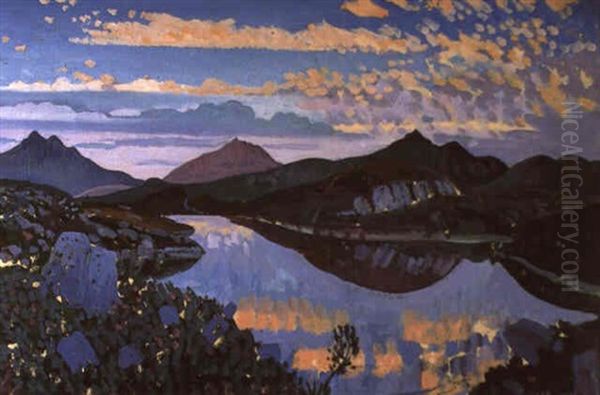
The artists would often stay at the Rhyd-y-fen, a remote inn near the mountain, and embark on painting expeditions into the surrounding countryside. They sought to capture the raw, untamed spirit of the Welsh landscape, moving away from the picturesque conventions of earlier landscape painting. Innes, in particular, seemed to find a profound spiritual connection with these mountains. His paintings of Arenig Fawr, such as Arenig, North Wales (c. 1913) and Bala Lake (c. 1911), are among his most powerful and iconic works. They are characterized by their intense colour, simplified forms, and a palpable sense of atmosphere, often conveying a feeling of solitude and grandeur.
The collaboration with Augustus John was particularly significant. John, already an established and somewhat notorious figure in the art world, was a charismatic personality and a powerful draughtsman. His bohemian lifestyle and artistic confidence undoubtedly influenced Innes. Conversely, Innes's passionate engagement with landscape and his innovative use of colour seem to have inspired John to explore new directions in his own landscape painting during this period. Their shared expeditions and artistic dialogue created a fertile ground for experimentation. Derwent Lees, an Australian-born artist, also contributed to this creative synergy with his own distinctive, brightly coloured landscapes.
Travels and Broadening Horizons
The spectre of ill health loomed large over Innes's life. He was diagnosed with tuberculosis at a young age, a disease that would ultimately cut short his promising career. On medical advice, he sought warmer climates, leading to several trips to the South of France and Spain between 1908 and 1913. These travels provided new subject matter and further stimulated his artistic development.
In 1908, he visited the small fishing town of Collioure in the French Pyrenees, a location famously painted by Henri Matisse and André Derain, key figures of Fauvism. The intense light and vibrant colours of the Mediterranean landscape resonated deeply with Innes's artistic temperament. Works such as Mediterranean Coastal Scene (1911) and Vernet (1912), likely depicting scenes from his travels in France or Spain, showcase his mastery of colour and his ability to convey the sun-drenched atmosphere of these southern climes. He also travelled to Spain, producing evocative works like Spanish Landscape (1912). A trip to Morocco in 1913 with the artist Trelawney Dayrell Reed further expanded his visual vocabulary.
These journeys not only offered a temporary respite from his illness but also exposed him to different light conditions and cultural environments, enriching his palette and compositional strategies. His paintings from this period often feature simplified architectural forms set against dramatic mountain backdrops, rendered in his characteristic bold and expressive style.
Anecdotes and Personality

Innes was known for his somewhat eccentric and romantic personality. He cultivated an interest in Romani (Gypsy) culture, a fascination shared with Augustus John. This interest was sometimes reflected in his attire; he was known to favour a wide-brimmed black hat and a somewhat bohemian style of dress, which, according to some accounts, made him resemble a "typical Gypsy." This romantic inclination perhaps also fuelled his attraction to wild, untamed landscapes and his desire to live and work in close communion with nature.
His working method was often rapid and intense. He preferred to paint directly from nature, often completing a small oil sketch in a single session. This immediacy is palpable in his work, which retains a sense of freshness and spontaneity. Despite his illness, he possessed a remarkable creative energy and a passionate dedication to his art.
Exhibitions and Recognition
Despite his short career, Innes achieved a degree of recognition during his lifetime. He exhibited regularly with the New English Art Club, a progressive exhibiting society that provided an alternative to the more conservative Royal Academy. His work was also shown at the Chenil Galleries in Chelsea, which was run by Augustus John's associate, Knewstub.
A significant moment of international recognition came in 1913 when his work was included in the groundbreaking Armory Show (officially the International Exhibition of Modern Art) in New York, Chicago, and Boston. This exhibition, which introduced American audiences to European avant-garde art, featured Innes's paintings alongside those of luminaries such as Paul Cézanne, Vincent van Gogh, Paul Gauguin, Henri Matisse, and Pablo Picasso. The inclusion of his work in such a prestigious and influential exhibition underscored his growing reputation as a significant modern British painter. His work was championed by the American collector John Quinn, who purchased several of his paintings.
Representative Works
Innes's oeuvre, though relatively small due to his early death, contains a number of remarkable paintings that exemplify his unique vision.
Arenig, North Wales (c. 1913, Tate): This is perhaps one of his most iconic depictions of his beloved mountain. The painting uses bold, simplified forms and a palette of intense blues, purples, and greens to convey the majestic and somewhat brooding presence of Arenig Fawr. The sky is often dramatic, contributing to the overall emotional impact.
Bala Lake (c. 1911, Manchester Art Gallery): This work captures the serene beauty of the lake with Arenig Fawr often visible in the distance. Innes uses fluid brushstrokes and a harmonious colour scheme to evoke the tranquil atmosphere of the scene.
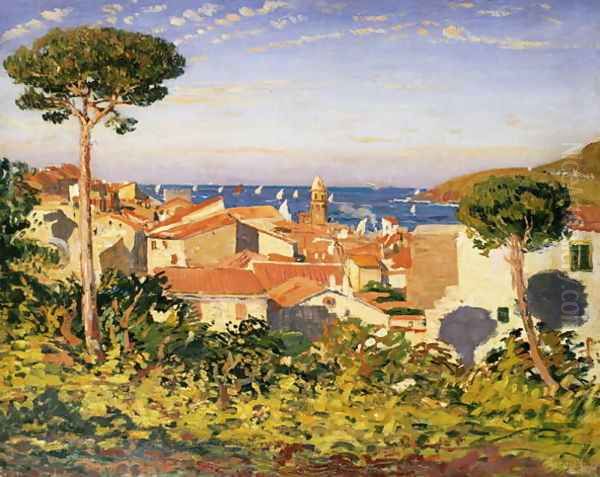
The Waterfall (1911, National Museum Wales): Demonstrating his ability to capture movement and the raw energy of nature, this painting uses dynamic brushwork and vibrant colours to depict the cascading water.
Collioure (various versions, e.g., c. 1911, Glynn Vivian Art Gallery): Paintings from his time in the South of France are characterized by their bright, sun-drenched palettes and simplified forms, reflecting the influence of the Mediterranean light and perhaps the spirit of Fauvism. Mediterranean Coastal Scene (1911) is another fine example from this period.
Canigou (c. 1912-1913, National Museum Wales): Mount Canigou, a sacred mountain in the Catalan Pyrenees, was another peak that captivated Innes, likely due to his maternal Catalan heritage and its proximity to Collioure. His depictions of Canigou are often imbued with a mystical quality, using rich blues and purples.
The Rock Pool (1911): This work showcases his ability to find beauty and abstract patterns in more intimate natural settings, using bold colours and simplified shapes to represent the interplay of water, rock, and light.
Llyn Cae (Cader Idris) (c. 1913): Depicting another dramatic Welsh mountain lake, this painting exemplifies his mature style, with its expressive use of colour and strong compositional sense.
These works, and others like Vernet (1912) and Pasture with Horses (c. 1913), demonstrate Innes's consistent ability to transform observed reality into powerful, emotionally charged images.
The Shadow of Illness and Premature Death
Throughout his adult life, James Dickson Innes battled tuberculosis. The disease, often romanticized in the 19th and early 20th centuries but invariably debilitating, cast a long shadow over his existence. His travels to warmer climes were partly an attempt to alleviate its symptoms and prolong his life. However, his health continued to deteriorate.
Despite his failing strength, he continued to paint with remarkable fervour. There is a sense in some of his later works of an artist racing against time, pouring all his energy and passion into his art. The intensity of his vision and the vibrancy of his colours seem almost defiant in the face of his illness.
James Dickson Innes died on August 22, 1914, at a nursing home in Swanley, Kent, at the tragically young age of 27. His death occurred just as World War I was beginning, an event that would irrevocably change the artistic and cultural landscape of Europe.
Legacy and Posthumous Reputation
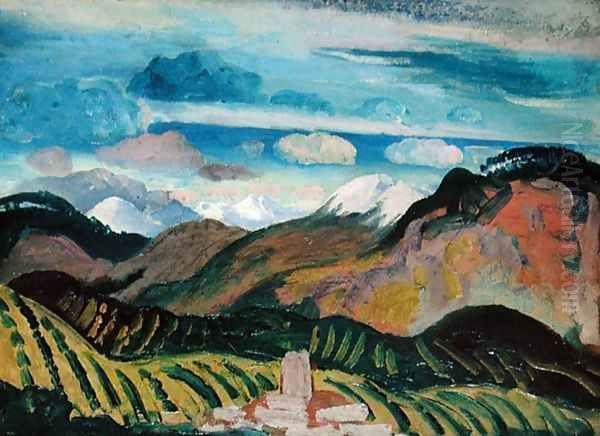
Though his career spanned less than a decade, James Dickson Innes made a significant contribution to British art. He is recognized as one of an important generation of British artists who responded to the innovations of French Post-Impressionism and sought to create a distinctly modern British art. His work stands apart for its intense lyricism, its bold and expressive use of colour, and its profound connection to the spirit of place, particularly the Welsh landscape.
His association with Augustus John and the Arenig School, though brief, was a vital episode in the story of Welsh art and British landscape painting. He helped to pioneer a new way of seeing and depicting the Welsh mountains, moving beyond picturesque representation to a more subjective and emotionally charged interpretation. Artists like Kyffin Williams, a later giant of Welsh landscape painting, acknowledged the pathfinding work of Innes and John in celebrating the rugged beauty of their homeland.
Innes's paintings are held in major public collections in the United Kingdom, including the Tate Britain, the National Museum Wales in Cardiff, the Glynn Vivian Art Gallery in Swansea, and Manchester Art Gallery. Retrospective exhibitions of his work have helped to solidify his reputation and introduce his art to new generations.
He is often seen as a quintessential romantic figure – a passionate, bohemian artist whose life was cut short in its prime. However, his artistic legacy transcends this romantic image. His paintings are admired for their intrinsic artistic qualities: their daring colour, their expressive power, and their ability to evoke the profound emotional impact of landscape. He was a vital link in the chain of British landscape tradition, infusing it with a modern sensibility that looked towards European developments while remaining deeply rooted in his native soil. His influence can be seen in the work of later British landscape painters who sought a more personal and expressive engagement with nature, such as Paul Nash and Graham Sutherland, both of whom also found inspiration in the unique character of the British landscape.
In conclusion, James Dickson Innes was a painter of rare talent and intense vision. His vibrant, emotionally charged landscapes, particularly those of the Welsh mountains, represent a significant contribution to early 20th-century British art. Despite the brevity of his life, his work continues to resonate with its passionate celebration of nature and its bold embrace of modern artistic principles, securing his place as a unique and cherished figure in the history of art.